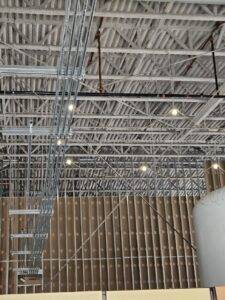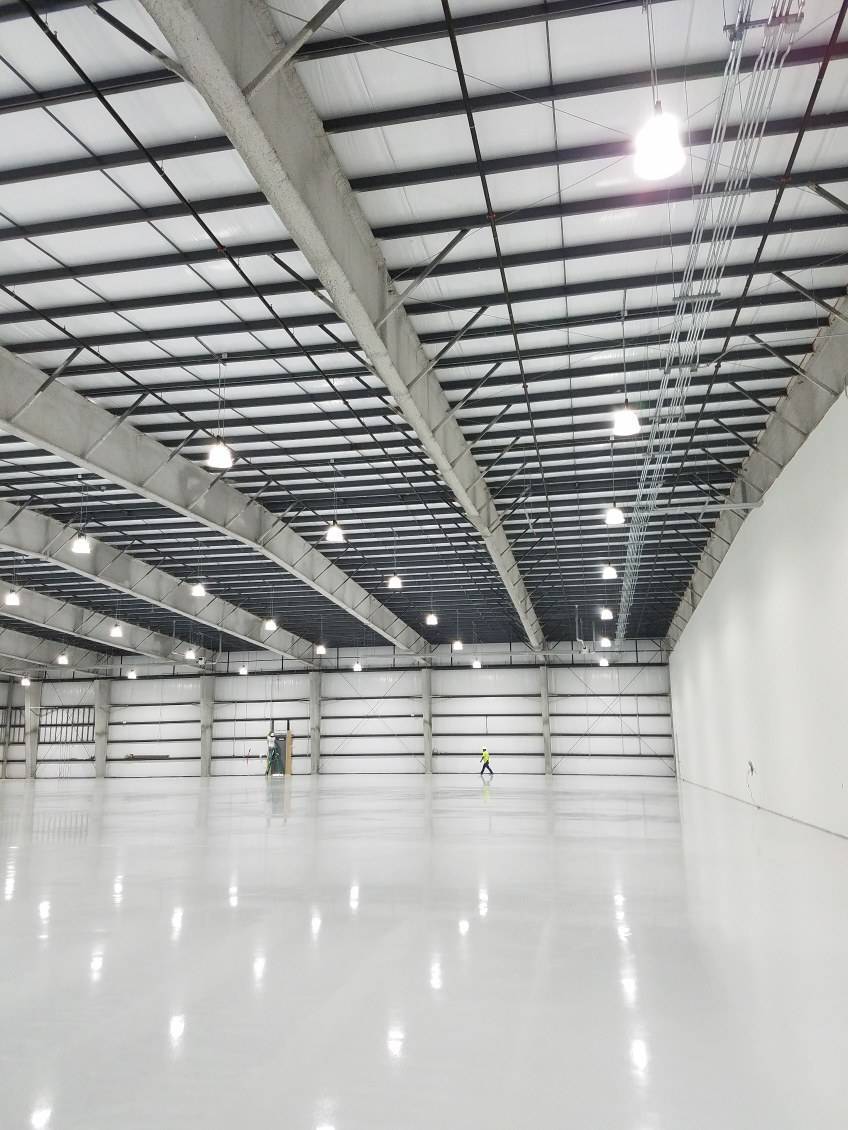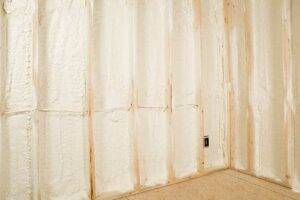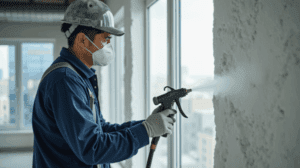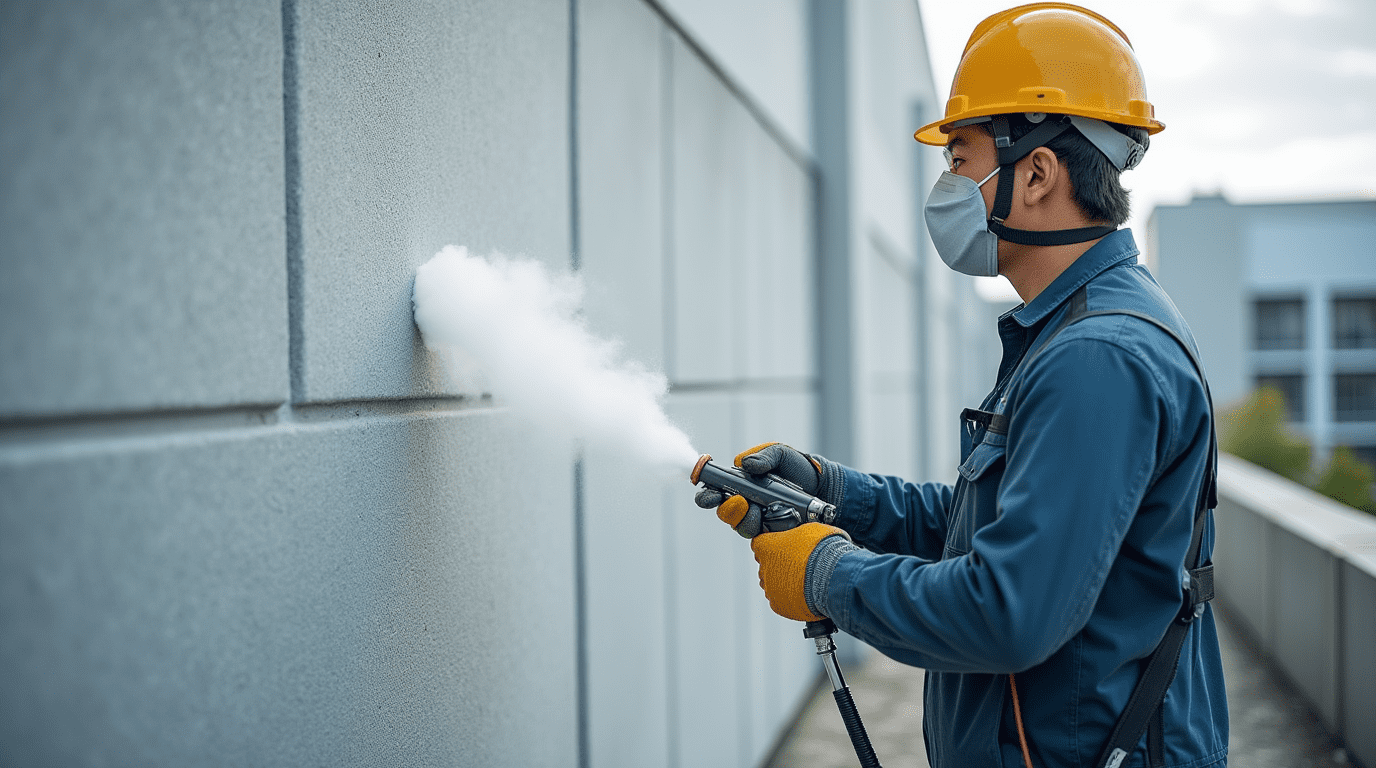Why Surface Preparation Matters in Commercial Fireproofing
Bahl Fireproofing
Summary: Surface preparation directly determines whether fireproofing systems perform as designed during fire events. Contaminants like oil, grease, and loose mill scale prevent proper bonding, leading to system failures that compromise structural protection. Understanding code-mandated surface preparation requirements, proper cleaning methods, and inspection protocols ensures fireproofing installations meet International Building Code bond strength minimums and provide reliable fire resistance.
TLDR: Proper fireproofing surface preparation removes contaminants that prevent bonding, maintains minimum temperatures during application, and meets IBC-mandated bond strength requirements of 150 to 600+ psf depending on building height. Poor surface prep is the leading cause of fireproofing failures. Solvent cleaning, mechanical preparation, and manufacturer approval are non-negotiable steps before any spray-applied or intumescent fireproofing application begins.
The Hidden Failure Point in Fire Protection Systems
Fireproofing systems don’t fail during installation. They fail months or years later when bond strength proves inadequate, or worse, during an actual fire when the protection delaminates from structural steel. Forensic investigations consistently identify inadequate surface preparation as the primary cause of these failures.
International Building Code Chapter 17 requires special inspection of fireproofing surface preparation before application begins, and manufacturers must certify surface acceptability in writing. These aren’t administrative formalities. Surface condition directly determines system performance when buildings depend on passive fire protection to maintain structural integrity.
Commercial Fireproofing Surface Preparation: Contaminants That Cause Failure
Steel arrives on job sites with various surface conditions, and not all are acceptable substrates for fireproofing. Oil and grease create hydrophobic barriers that prevent chemical bonding between fireproofing materials and steel. Even thin oil films invisible to the naked eye can reduce bond strength below code minimums. Loose mill scale detaches under thermal stress during fire exposure, taking fireproofing material with it. While tightly adhering mill scale that survives blast cleaning may remain, any loose or flaking scale must be removed through mechanical cleaning.
Dirt, dust, and incompatible primers also prevent proper bonding. Construction sites generate significant airborne particulates that settle on steel surfaces and must be removed before application. Some primers are specifically formulated and tested for compatibility with spray-applied fireproofing, but many standard shop primers fail ASTM E736 bond strength testing requirements and must be removed or reinforced with mechanical lath.
Surface Preparation Standards for Fireproofing Applications
The SSPC (Society for Protective Coatings) publishes industry-standard methods for steel surface preparation. SSPC-SP 1 (Solvent Cleaning) removes oil, grease, and soluble contaminants using solvents, steam, or emulsifying agents. This is the minimum required surface preparation for most commercial fireproofing applications on unpainted steel. Solvent cleaning does not remove rust, mill scale, or existing coatings, but it eliminates the hydrophobic barriers that prevent chemical bonding.
SSPC-SP 3 (Power Tool Cleaning) uses mechanical methods like scraping, wire brushing, and grinding to remove loose paint, rust, and mill scale. This method applies when blast cleaning isn’t feasible due to site constraints. SSPC-SP 6 (Commercial Blast Cleaning) requires surfaces to be two-thirds clean bare metal, with tightly adhering coatings or mill scale allowed to remain if they survive the blast process. This standard balances thorough cleaning with practical economics for large commercial projects.
Higher blast standards like SSPC-SP 10 (Near-White Metal) and SSPC-SP 5 (White Metal Blast) achieve 95% and 100% bare metal cleanliness respectively, but are rarely required for standard fireproofing applications. These methods apply primarily in harsh industrial environments like refineries and offshore platforms.
Temperature Requirements for Fireproofing Surface Preparation
Environmental conditions during application directly affect cure chemistry and bond development. Substrate and ambient temperatures must reach 40°F minimum and remain at or above 40°F for 24 hours before application, throughout the application process, and for 24 hours after application completes. Below 40°F, water in spray-applied fireproofing mixtures begins freezing, preventing proper hydration of cementitious binders. Cold substrates prevent chemical bonding even if ambient air temperature meets minimums.
When substrate or ambient temperatures fall below 40°F, contractors must provide temporary enclosures and heating systems to maintain proper conditions. Humidity and ventilation also affect cure times, with most specifications requiring minimum four air changes per hour and proper moisture control during the typical 14 to 28 day cure period.
Primed Steel and Metal Lath Reinforcement
Structural steel often arrives with shop-applied primers for corrosion protection. IBC Section 714.8 allows fireproofing over primers only when beam flange widths are 12 inches or less, column flange widths are 16 inches or less, and web depths are 16 inches or less. Bond strength testing per ASTM E736 is mandatory unless the primer appears on the manufacturer’s pre-approved compatibility list, with results showing at least 80% average bond strength compared to clean uncoated steel.
When members exceed size limits or bond tests fail, contractors must install metal lath before fireproofing application. The expanded diamond mesh provides mechanical reinforcement when adhesive bonding alone cannot meet code requirements. For projects involving intumescent fireproofing on primed steel, surface preparation becomes even more critical due to thinner coating profiles that depend heavily on chemical bonding. Metal lath adds $1.50 to $3.00 per square foot but prevents system failures requiring complete removal and reapplication at $15 to $30 per square foot.
Commercial Fireproofing Surface Preparation: Inspection and Testing Protocols
Code compliance requires documented inspection at multiple stages. Pre-application surface inspection occurs before any fireproofing material touches steel. The manufacturer’s representative must inspect prepared surfaces and provide written certification that conditions will not impair bonding. This inspection verifies removal of all prohibited contaminants, confirms acceptable temperature and humidity conditions, and checks that all structural attachments are installed.
Bond strength testing per ASTM E736 measures cohesion and adhesion through tensile pull tests on cured fireproofing. A 2-inch diameter metal cap bonds to the fireproofing surface, then force is applied perpendicular to the substrate until failure occurs. IBC establishes minimum bond strength requirements that increase with building height: 150 psf for standard construction, 430 psf for buildings 75 to 420 feet tall, and 600 psf minimum for super high-rise structures exceeding 420 feet.
Testing occurs on in-place fireproofing after adequate cure time, typically 14 to 28 days depending on environmental conditions. Projects require minimum five test locations with both average and individual test results meeting specified minimums. Thickness and density verification through ASTM E605 testing ensures installed fireproofing meets fire resistance design requirements, with density typically ranging from 15 to 40 pounds per cubic foot.
Proper surface preparation adds time and expense to fireproofing projects, but the cost of failure makes this investment essential. Solvent cleaning, blast cleaning ($2 to $8 per square foot), and bond testing ($500 to $1,500 per location) prevent complete system failures that cost $15 to $30 per square foot to remediate. Surface preparation requires one to two weeks before fireproofing application begins, but discovering deficiencies after application multiplies both cost and time impacts.
Key Takeaways
- Surface preparation directly determines fireproofing system performance during fire events, with poor preparation identified as the leading cause of system failures in forensic investigations
- Oil, grease, loose mill scale, dirt, and incompatible primers must be removed through solvent cleaning, mechanical preparation, or blast cleaning before fireproofing application
- Temperature requirements mandate minimum 40°F substrate and ambient conditions for 24 hours before, during, and after application to ensure proper bonding
- Primed or painted steel requires ASTM E736 bond strength testing unless the primer appears on manufacturer pre-approved lists, with mechanical reinforcement required when tests fail
- IBC bond strength minimums increase with building height from 150 psf standard to 600+ psf for super high-rise construction
- Metal lath provides mechanical reinforcement when adhesive bonding proves inadequate, costing $1.50 to $3.00 per square foot versus $15 to $30 per square foot for complete system replacement
- Manufacturer inspection and written approval of surface conditions is mandatory before fireproofing application begins
Getting Surface Preparation Right From the Start
Fire protection isn’t something you can retrofit after discovering bond failures. Surface preparation happens once, before fireproofing application, and determines whether passive fire protection systems perform as designed when buildings depend on them most.
If your project requires fireproofing that bonds properly to structural steel and meets code requirements without costly rework, start with contractors who understand that surface preparation isn’t a step you skip to save time. Contact Bahl Fireproofing today to discuss your project requirements and schedule a pre-application surface inspection.
Disclaimer: This article provides general educational information about fireproofing and insulation systems and does not constitute professional engineering advice or product specification. System selection must be based on project-specific fire ratings, thermal requirements, acoustic performance needs, environmental conditions, substrate requirements, and budget constraints. Code requirements vary by jurisdiction and project type. Always consult with a licensed professional and verify UL or FM assembly listings before finalizing specifications.

